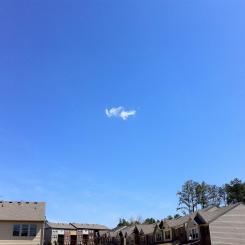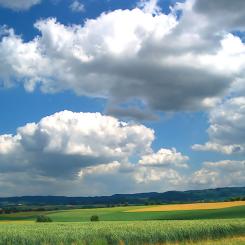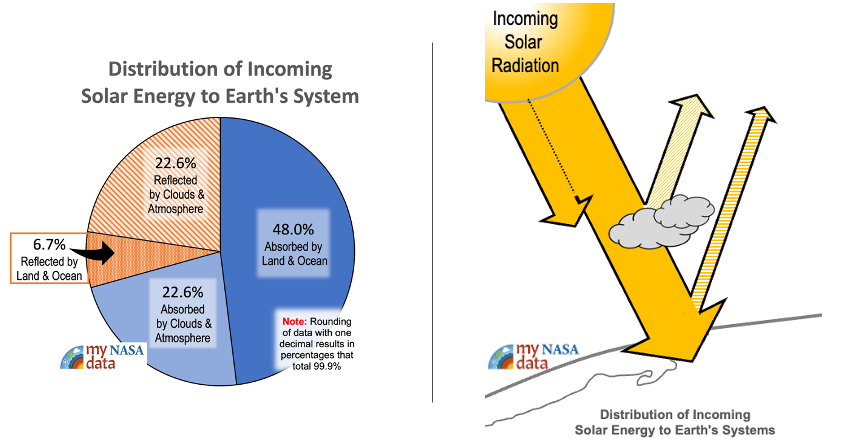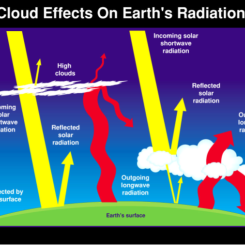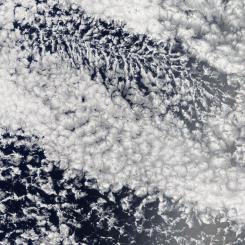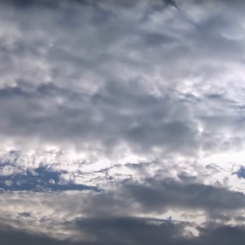Lesson Plans
Clouds & Their Impact on Global Warming
Overview
Students will investigate the role of clouds and their contribution (if any) to global warming. Working in cooperative groups, students will make a claim about the future role clouds will play in Earth’s Energy Budget if temperatures continue to increase. Students will back up their claim by examining various pieces of evidence to produce a written response. Groups will present their findings to the class on poster board or mini white boards.
Materials Required
- Video The Climate Wild Card
- Diagram Cloud Effects On Earth's Radiation
- Article Clouds & Global Warming
- Article How Do Clouds Affect Earth’s Climate
- Video Clouds & Earth’s Climate - Patrick Taylor
- Student Handout Clouds & Their Impact on Global Warming
- Poster Board or Mini White Boards
Procedure
- To get students thinking about clouds and their role in Earth’s Energy Budget, start the lesson off by having students watch the NOVA PBS video entitled The Climate Wild Card.
- After the video, check for student understanding by asking some of the questions below:
- According to the video, what percentage of the sky do clouds cover?
- What do clouds have a large influence on?
- What happens to the Sun’s solar radiation after it enters Earth’s atmosphere?
- How do clouds influence the energy exchange between Earth and space?
- True or False: Clouds reflect more energy than they absorb.
- What would happen to Earth if it were completely cloudless?
- Identify the following types of clouds as absorbers or reflectors and state whether they have a cooling or warming effect on the planet:
- Cirrus Clouds
- Stratus Clouds
- With the level of greenhouse gases in the atmosphere rising and the Earth’s temperature increasing, how will this affect clouds?
- What is the burning question for climate scientists?
- What do scientists theorize could happen to clouds as the planet warms?
-
Stress to students the importance of clouds and their important (yet complicated) role in Earth’s Energy Budget and Earth’s temperature. Repeat the statement from the video that clouds can have both a cooling and warming effect on Earth’s temperature.
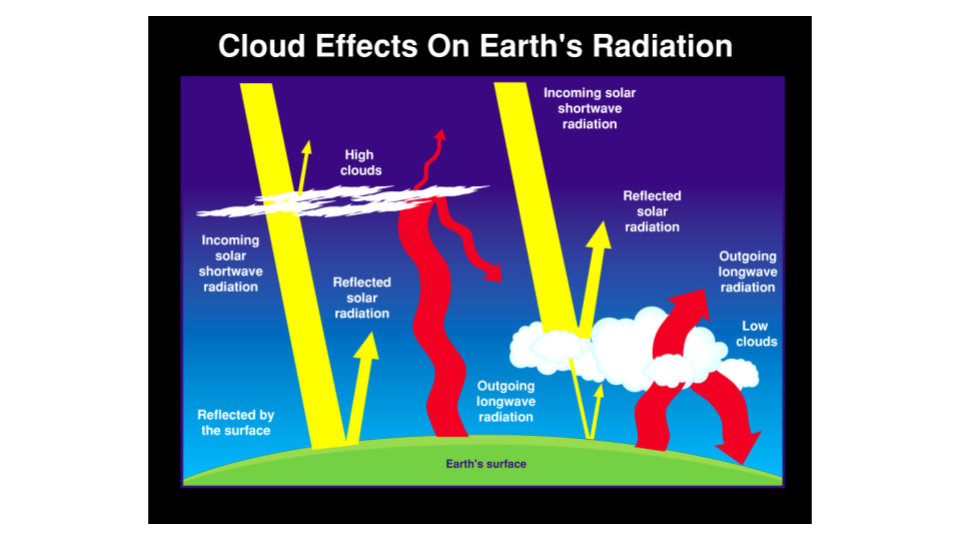
Cloud Effects on Earth's Radiation
Credit: NASA
https://mynasadata.larc.nasa.gov/sites/default/files/2022-08/cloudseffectsonearthsradiation.png - Have students explore this idea further by looking at the diagram Cloud Effects On Earth's Radiation.
- Inform students that the yellow arrows on the diagram represent incoming shortwave radiation from the sun. The red arrows represent longwave radiation emitted (released) by Earth.
- Have students examine the diagram and answer the following questions:
- Check out the yellow arrows showing incoming shortwave radiation. What is the difference between the amount of incoming shortwave radiation transmitted through high-level clouds and low-level clouds?
- Investigate the red arrows showing outgoing longwave radiation. What is the difference between the amount of outgoing longwave radiation transmitted through high-level clouds and low-level clouds?
- Compare the yellow arrow reflected by the high cloud to the red arrow leaving the base of the high cloud and pointing toward the surface. Overall, what effect do high-level clouds have on the atmosphere?
- Differentiate between the yellow arrow reflected by the low cloud to the red arrow leaving the base of the low cloud and pointing toward the surface. Overall, what effect do low-level clouds have on the atmosphere?
- Next, break the class up into groups of 3 or 4 students.
- Pass out the student handout Clouds & Their Impact on Global Warming. This is a C-E-R Response sheet in which students will be making a claim, examining evidence, and providing a detailed response.
- Explain to students that they will be examining the following pieces of evidence to answer the probing question “What effect will clouds have on global warming”?
- Once the groups have examined all evidence pertaining to clouds and global warming, they will copy their C-E-R response on a poster board or mini white board.
- Lastly, have groups present their findings to the class and explain the role clouds will play in global warming.
Answer Key:
Teachers who are interested in receiving the answer key, please complete the Teacher Key Request and Verification Form. We verify that requestors are teachers prior to sending access to the answer keys as we’ve had many students try to pass as teachers to gain access.
Sources:
- The Climate Wild Card. (n.d.). PBS Learning Media. Retrieved July July 22, 2022, 2022, from https://virginia.pbslearningmedia.org/resource/nvcl.sci.earth.wild/the-…
- Clouds and Global Warming. (2010, June 9). NASA Earth Observatory. Retrieved August 2, 2022, from https://earthobservatory.nasa.gov/images/44250/clouds-and-global-warming
- How Do Clouds Affect Earth's Climate? (2022, May 31). NASA Climate Kids. Retrieved August 2, 2022, from https://climatekids.nasa.gov/cloud-climate/
- Science of Clouds Videos - S'Cool. (n.d.). GLOBE.gov. Retrieved August 2, 2022, from https://www.globe.gov/web/s-cool/home/science-of-clouds
Disciplinary Core Ideas:
- ESS1B: Earth and the Solar System
- ESS2A: Earth Materials and Systems
Crosscutting Concepts:
- Cause and Effect
- Stability and Change
Science and Engineering Practices:
- Developing and Using Models
- Internet Required
- One-to-One (tablet, laptop, or CPU)

